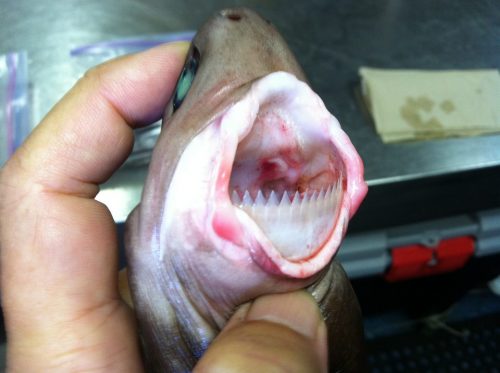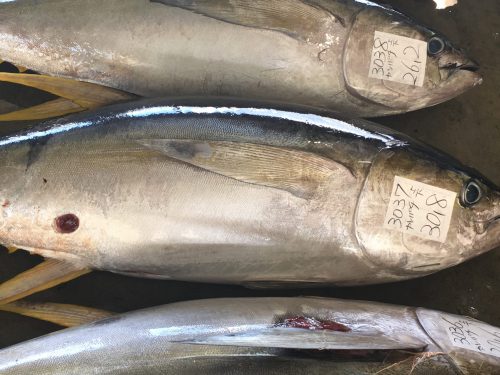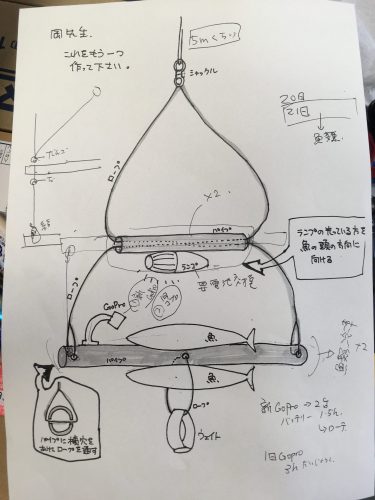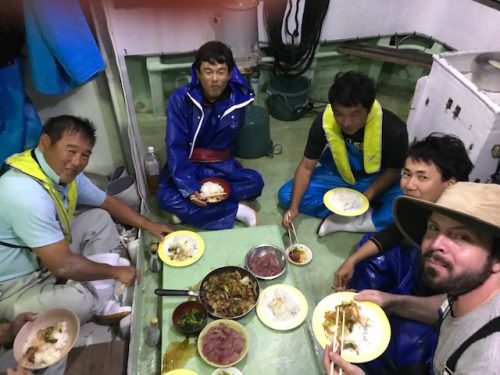Many questions scientists get asked relate in some way to why we do work for the sake of it; most often, data itself does not have an immediate return on investment. However, data is needed before returns under a respectable model can ever be projected.
This distinction is made plain by research projects that begin with simple premises. For example, we are interested in how a diminutive, ungainly shark feeds. This shark is the cookiecutter shark (Isistius brasiliensis), made somewhat infamous as the cause of several punch-hole marks on the rubber coverings of US submarine radar devices during the Cold War.
The subject of how this shark feeds may seem akin to the “shrimp on a treadmill” study maligned earlier this decade by certain groups as an example of waste in scientific effort and funding. After all, we see certain sharks eating, often in slow-motion and at high-definition, on television programs rather frequently at certain times of the year, and so many might consider the matter quite settled. However, the simple premise belies a far more complicated reality.
There are over four-hundred species of sharks alive today (the fossil record includes many more), and not all of them feed with this commonly-recognized bite- and/or bite-and-shake method. Some sharks swim with open mouths to filter plankton, and do not bite at all; others ingest prey whole, making biting irrelevant.
The cookiecutter shark, however, exhibits an especially gruesome kind of bite, leaving eerily symmetrical crater wounds on the surfaces of larger fishes, open-water swimmers, other sharks, and sometimes drowning victims. These wounds bleed profusely and heal slowly. It, therefore, stands to reason that, given this macabre feeding strategy, it must be one of the most studied examples of shark feeding behavior. Strangely enough, this is not the case.
Some evidence linking this shark to its signature wound came from a 1971 study in which a researcher used a dead cookiecutter shark like a melon-baller on the surface of a nectarine to successfully reproduce the shape of the crater wound and coaxed a bedraggled, net-caught specimen to affix itself to the surface of a dead fish. Legal counsel would call such evidence circumstantial, but this work, done without an anticipated return on investment, highlighted a new conundrum related to Isistius feeding—that the shark could potentially generate astonishingly high pressures within its oral cavity. But how?
Evolution builds things with what it has to work with, and sometimes the solutions appear to use what engineers might consider unorthodox materials and configurations. The cookiecutter shark has what amounts to a razorblade-lined bucket for a lower jaw; a floppy Velcro pad for an upper jaw; a fleshy O-ring for lips; a plunger for a tongue; and an unusual branching configuration of cranial muscles linked to its pectoral fins.

Somehow, these components successfully produce the characteristic bite wound. This toolkit works, as engineers have, it turns out, independently replicated the general mechanics in a suction-based tool used for human rectal biopsy.
But such biopsy plugs are often small, excised from soft tissue, and done on sedated patients. Extracting larger plugs, of denser tissue, from prey animals that would prefer not to be bitten is another matter, especially given the cookiecutter shark’s lackadaisical swimming pace. Intuition suggests the bite must be quick, so why not keep one in a tank to confirm this suspicion?
Tank-based studies are a traditional staple of feeding research, which is often under the purview of a field of biology known as biomechanics. Much of what we know about the engineering, fluid flow, and energetics of fish and shark feeding comes from the labs dedicated to this field of research. The study animals are acclimated to tanks and sometimes fitted with pressure sensors through the gill slits. Some fishes figure out that food will arrive no matter what they do, and change their behavior accordingly. Wiliness aside, acclimation is stressful and can take several weeks. The cookiecutter shark is a midwater species, meaning it lives predominantly in the upper level of what we know as the “deep-sea” environment, and previous efforts to keep them in tanks have failed. Deep-sea vertebrates do not survive long in aquaria; the record is around two weeks, which precludes the possibility of tank-based observation of acclimated cookiecutter shark feeding behavior and oral pressure measurement.
Or does it? Scientific research often needs to be clever in order to formulate questions in ways that can be addressed with the equipment on hand. There are several ways to measure pressure indirectly if direct measurement through the gills is impossible. One of these ways is at the surface to which the cookiecutter shark attaches itself before biting, as this surface would experience the effects of negative pressure generated inside the shark’s oral cavity. With this in mind, we might design an experiment where a caught shark would bite a surface covered with a pressure plate of some sort. Such a plate would need to be inconspicuous, be able to measure negative pressure, be operable in saltwater, and work at depth. But do such sensors exist?
We posed the problem to two different sensor companies, both of whom were excited by the project when we described it to them. It turns out, however, that no existing technologies satisfy all the requirements. Cookiecutter shark feeding poses a unique measurement problem. And we still have not observed a complete feeding event, regardless of pressure measurement.
Scientific research is a global endeavor, and interesting problems, such as the cookiecutter shark puzzle, do not conform to national boundaries. Last fall, we were funded by the Okinawa Churashima Fund (OCF) to travel to Japan, and with OCF staff attempt to document cookiecutter shark feeding. We considered pressure to be the major feature of the feeding event. Strong enough pressure would cause a bulge of tissue into the shark’s oral cavity, and under these circumstances, a bite straight across this tissue would appear as a crater wound after the fact. Our sponsor favored a hypothesis from the literature that proposed a bite-and-twist approach. Our friendly disagreement had led to the project getting funded.
We flew in over the remnants of Typhoon Hagibis.
I had personal experience catching cookiecutter sharks. In four trips aboard a National Oceanic and Atmospheric Association (NOAA) research vessel, these sharks were not infrequently encountered as pests in trawls and were considered a liability as they were known to bite the trawl receptacle and compromise net integrity by causing blowouts through the semicircular holes they left behind.
These encounters had been variable in frequency. Once, we had potentially six cookiecutter sharks in a single trawl. Other times, we had encountered one the entire trip. However, wounds we observed on fish auction tuna and mahi-mahi caught in the vicinity of our Okinawa expedition sites suggested the sharks were active in the area (Fig. 2).

I had personally never considered how a cookiecutter shark might be caught without a trawl net, but our sponsor had an elegant solution. Rather than attempt to capture the sharks, we would video the feeding events using a GoPro and an illuminated bait fish anchored to a PVC armature (Fig. 3). This way, given its natural setting, the video would help us determine not only the bite method of the shark but also its natural method of approach to prey.
However, taking this tack meant we had to incorporate everything known about the zoology of the cookiecutter shark. Midwater organisms follow what is known as a diel

cycle, meaning that they migrate closer to the surface at night, with activity also influenced by the lunar cycle. Cookiecutter sharks have in the past been caught at night in the upper 20 meters of water, but the open ocean is generally empty, and as far as we know, cookiecutter sharks do not school or swarm, so encountering an aggregation of them was unlikely. Our hosts’ solution was to drop the camera setups near an anchored Fish Aggregating Device (FAD), known locally as a payaos, a piece of equipment designed to attract fishes of commercial interest, such as tuna and billfish which, based on previous prey preference studies, appeared to be preferentially targeted by cookiecutter sharks. If these preferred prey were in the area, it was reasonable that we might see cookiecutter sharks, as well.
Getting to the payaos, however, required a three-hour trip one-way. We were fortunate the Okinawa Churaumi Aquarium owned a vessel, the Kuroshio, on whose operations we were allowed to piggyback. We left in the morning, heading west from the harbor, and moved from patch to patch, occasionally following aggregations of seabirds, helping with vessel operations catching tuna for the aquarium’s live tank. As the sun set, we had a meal on the back deck and then prepared the rigs for night operations. We were limited in the amount of time we could deploy, due to the battery limitations of the GoPros, but managed to get two two-hour deployments in per night. In the morning, we would return to the harbor. We went out four times but did not see a cookiecutter shark.
What began with a gory bite and a question ended with sleeping over a hold full of tuna, on a windy ship deck off the coast of Okinawa. It did not go as we had thought it might, but today’s nothing is tomorrow’s something, and this is why we work.

We would like to thank Taketeru Tomita; Keiichi Sato; Keiichi Ueda; Shin-Ichiro Oka; Kei Miyamoto; Nozomi Kobayashi; Rui Matsumoto; Masaru Nakamura; Kiyomi Murakumo; and the staff and crew of the OCF vessel Kuroshio, the Okinawa Churaumi Aquarium, and the URM Fish Collection for making this trip and collaboration possible. More information about the Okinawa Churashima Foundation may be found at https://churashima.okinawa/en/ocrc/. The author would additionally like to thank NOAA PIFSC for collaboration through the years. The featured image at the top of the post is by Don Kobayashi, NOAA / PIFSC.